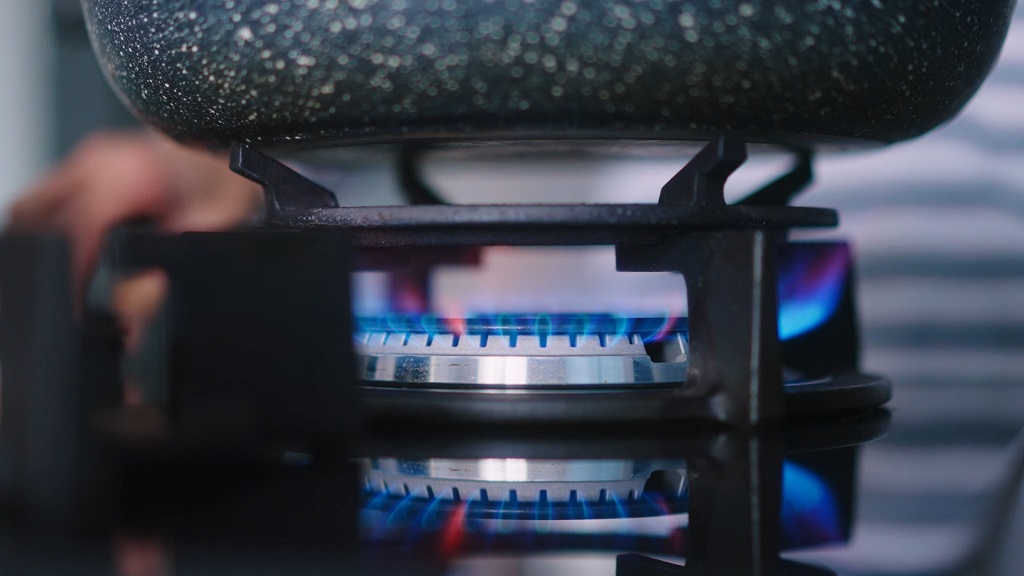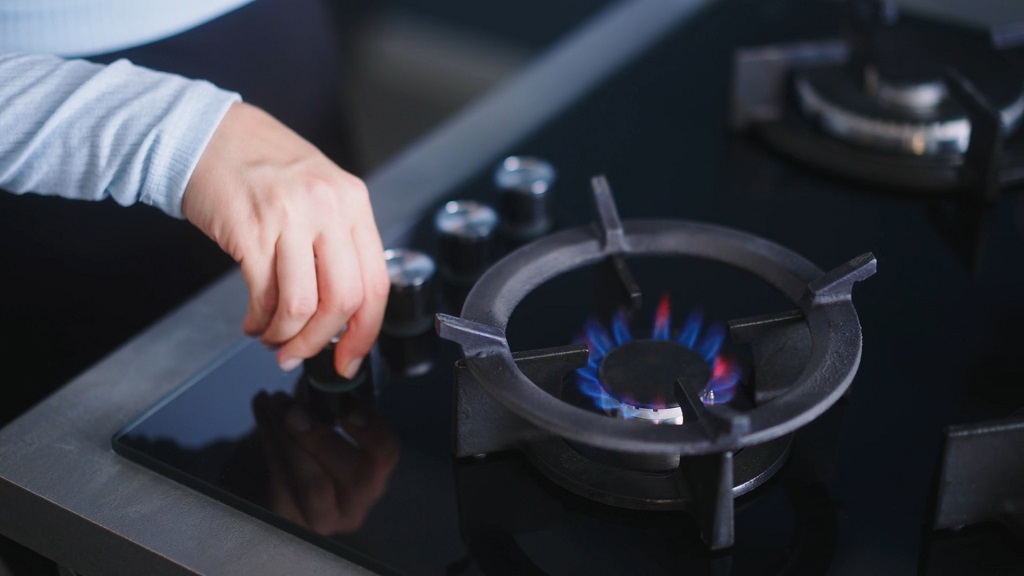Choosing between a gas and electric stove isn’t just about aesthetics or brand names anymore.
With energy efficiency, health concerns, and rising utility bills coming into sharper focus, more people are asking a practical question: which kind of stove actually uses less energy?
Let’s break it all down. Just real insights on energy use, costs, environmental impact, and what it’s actually like to cook on each type of stove.
Energy Efficiency

Energy efficiency comes down to how much of the energy actually goes into cooking your food, not just heating the air around your skillet.
Gas Stoves
Gas stoves hover around 40% efficiency. That means for every unit of energy burned, 60% is wasted. Most of that waste escapes as ambient heat into your kitchen or gets lost around the sides of your cookware.
If you’ve ever used a gas burner that’s too big for your pot, you’ve seen this in action. Flames lap up the sides, the handles get hot, the kitchen heats up – but the center of your pot takes forever to boil.
According to LeafScore, gas stoves take about 8.3 seconds to bring water to a boil.
Electric Stoves
Standard electric stoves (coil or smooth-top) perform significantly better – about 74% efficient, with only 26% energy loss. Heat transfers directly from the coil or glass surface to the pan, minimizing waste.
They’re not perfect, but they are much better at keeping the energy where it’s needed.
Induction (Worth Mentioning)
Induction stoves, though more expensive, are the champions of energy efficiency. They reach up to 90% efficiency, heating cookware directly via electromagnetic fields. No open flame. No wasted heat drifting into the air.
Boiling water? They can do it in about 5.8 seconds.
Interested in pairing your efficient stove with healthy meals? Check out some delicious keto recipes that work beautifully on induction cooktops.
Quick Reference Table
| Stovetop Type | Efficiency | Energy Waste | Notes |
| Gas | 40% | 60% | Lots of ambient heat loss |
| Electric (coil/glass) | 74% | 26% | Direct heat transfer to cookware |
| Induction | 84–90% | 10–16% | Heats fast, minimal waste |
Let’s say you boil water for pasta every day. Multiply that over a year, and even a 10–15% efficiency gain can save a significant chunk of energy.
Operating Costs

Even if electric stoves use energy more efficiently, the question most homeowners care about is: What’s cheaper?
Gas Stoves
Natural gas tends to be cheaper than electricity. That’s why gas stoves are often 10–30% cheaper to operate on a month-to-month basis.
If your utility bill includes a low gas rate, you might not notice the extra energy waste – at least not right away.
According to Earth.org, in 2022, 49% of U.S. households still relied on natural gas stoves, mostly because of lower operating costs and pre-installed hookups in many homes.
Electric Stoves
Electricity prices vary more across states and utility providers. In many regions, electric rates are higher than gas, so your monthly costs might go up even though you’re technically using less energy.
That said, if your home runs on a renewable-heavy electricity plan, or you’re eligible for federal or state incentives, the balance tips.
The Inflation Reduction Act offers rebates of up to $840 for switching to an electric or induction stove. Those rebates could easily offset the price difference in the first year.
Environmental Impact

The type of stove you choose doesn’t just affect your utility bill – it affects the planet, too.
Gas Stoves
Burning natural gas releases carbon dioxide (CO2). Even in short cooking sessions, gas stoves contribute to greenhouse gas emissions.
Boiling water on a gas stove for a few minutes? According to LeafScore, that single task can generate 1.16 lbs of CO2. Multiply that by every dinner you’ve ever made.
There’s also methane, a powerful greenhouse gas, that can leak from gas lines and connections even when the stove’s off. A Stanford study found that these small leaks happen more often than you might think.
Electric Stoves
The carbon footprint of electric stoves depends heavily on how your local electricity is generated.
If your electricity comes from coal, the emissions may still be significant – but thanks to efficiency, it’s usually less than gas.
If you’ve got access to wind, solar, or hydro power through your provider (which more than half of U.S. households now do), the impact drops dramatically.
That same pot of boiling water, on an induction stove powered by renewable electricity? It emits around 0.29 lbs of CO2 – less than a quarter of what gas produces.
Health Risks

This part doesn’t get talked about enough, but it probably should.
Gas Stoves
Gas stoves release byproducts from combustion – things like carbon monoxide, nitrogen dioxide, and formaldehyde. Without strong ventilation, those pollutants hang out in your kitchen and get into your lungs.
There’s growing evidence that gas stoves contribute to respiratory problems, especially in kids. A study cited by Earth.Org links gas stove use to 12.7% of childhood asthma cases in the U.S.
Even when turned off, some gas stoves leak small amounts of methane and other volatile compounds.
Electric Stoves
Electric stoves don’t burn fuel. That means no indoor pollutants, no carbon monoxide, and no chance of gas leaks.
For families with small kids, asthma, or allergies – or anyone living in a tightly sealed home – an electric or induction stove is the safer call.
Cooking Performance
Efficiency is only one side of the coin. People also care about how it feels to cook with each kind of stove.
Gas Stoves
Cooks love gas for a reason. It delivers immediate heat, which is great for stir-frying, searing, or sautéing.
You can see the flame, adjust it instantly, and feel in control. That said, it’s harder to keep a steady simmer. Flames can flicker or scorch depending on airflow and pan size.
Consumer Reports notes that while most gas stoves perform well overall, about 12% struggle with low-heat precision.
Electric Stoves
Electric burners take a little longer to heat up and cool down, but they’re great for even heating and temperature stability.
They outperform gas in baking and broiling tasks, and they’re much better for holding a steady simmer – think sauces, rice, or slow stews.
More than half of electric models tested by Consumer Reports scored Very Good or better for broiling performance.
Induction
If you want the best of both worlds – fast, responsive heat with clean energy – induction delivers. Just be prepared to invest in compatible cookware and a slightly higher upfront price.
Tips to Boost Energy Efficiency in Your Kitchen

Whether you’re working with gas, electric, or induction, small adjustments can make a big difference:
- Use the right pot for the burner size. A small pot on a big burner wastes energy fast.
- Cover your pots. Trapping heat cuts cooking time and reduces energy use.
- Keep your stovetop clean. Residue can interfere with heat transfer, especially on electric surfaces.
- Turn off early. On electric stoves, use residual heat to finish cooking after switching off the burner.
Example: Making chili? Use a lid, match the burner to the pot, and turn off the heat 5 minutes before the timer ends. That alone can save you 10–15% in energy for the dish.
Trends and Incentives
Policy and culture are pushing kitchens toward electric.
- The Inflation Reduction Act includes rebates up to $840 for switching to electric cooking appliances.
- States like California and New York are phasing out natural gas in new buildings.
- Groups like the Global Cooksafe Coalition advocate for induction stoves worldwide, citing both health and energy benefits.
With more renewable power entering the grid, and consumer incentives becoming easier to access, electric cooking is on the rise.
In fact, more homes are expected to switch over in the next five years than in the last two decades combined.
So, Which One Uses Less Energy?
When it comes to pure efficiency, electric stoves win – no contest. They transfer about 74% of energy to the food, compared to just 40% for gas. Induction stoves push that even further, up to 90%.
But the better question might be: what matters most to you?
- If you’re watching utility bills and have cheap gas service, gas may still be more affordable day to day.
- If you’re focused on health, clean air, or cutting emissions, electric is the safer and more sustainable option.
- If you want top-tier performance and don’t mind spending a little more upfront, induction might be worth the investment.
The smart move? Factor in your cooking habits, your local energy prices, and any available rebates before deciding. And if you’ve already got a gas hookup and can’t switch yet, you can still reduce waste with a few practical tweaks.
No matter what stove you use, thoughtful cooking saves energy. And that’s something every kitchen can get behind.

